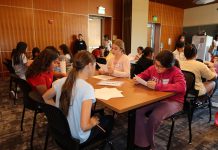
In 2003, I started a company that evolved into what we named “PlanReady.” As a school architect following the Columbine massacre in 1999, I realized that much of the information that the first responders, police and fire—and the school itself—should have had at their fingertips was unavailable to them.
<
Architectural plans, which might be available to public safety officials, are not helpful in an emergency as they are created for the purpose of building the structure and for that reason only. For example, site plans don’t typically have the floor plans overlayed so there is no clear illustration of the connection between site access and actual building configuration. There is nothing in architectural blueprints that identifies a main entry door or additional doors to the exterior, much less what they look like and how they are accessed.
<
The drawing room numbers are not the same. For example, it might be labeled Classroom 15 at the school and could be room 140 on the plans. This is a disconnect that could waste valuable time as responders try to decipher the plans when responding to an emergency.
<
All of this disinformation, combined with a lack of access to these marginally helpful plans, creates a black hole of how to act strategically in an emergency.
<
In the early 2000’s, Columbine was a one-off. Thus, the program that we developed with a staff of five software developers was viewed as a “nice to have,” but it generated little interest from venture capitalists who were focused on social media millions.
<
The program—a software-as-service model designed in dot-net—made it easy for any school, business or city to upload, overlay and configure building plans simply. It included special log-in views that included drag and drop icons that identified location, photos and instructions based on roles with the most important information available immediately, depending on the type of emergency at login.
<
For firefighters, all hose connections, fire alarms and identifying information of rooms, egress and structural concerns were identified. For police, camera locations and feeds as well room names, numbers, exits and lockdown information were available quickly and could be shared with other jurisdictions, throughout the local station, inside patrol cars and at the site—allowing for collaboration and rapid response.
<
School officials, city staff or business owners could log in at the same time as the first responders, providing additional necessary information.
<
In 2008, we put San Francisco City Hall up on PlanReady as a test, with many more buildings lined up to follow. But the recession hit and so went our ability to execute.
<
We are now in a new era where school shootings like the massacre at Columbine have become commonplace. Our built environment is still a question mark, with each project unique as to even something as simple as the locations of the electrical shutoffs. We need information about the building, how a campus functions and how to strategically manage an emergency.
<
Information is power. Does anyone want to pick up where we left off and do something to keep students, staff and first responders safe and more informed??
<
Lesley Miles, AIA, is an owner of Weston Miles Architects, developer of the Granary District, a mixed-use downtown Morgan Hill neighborhood, and founder of the technology company PlanReady. She can be reached at le****@**********ts.com.







